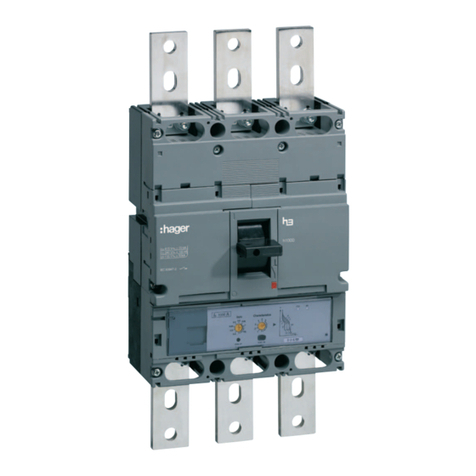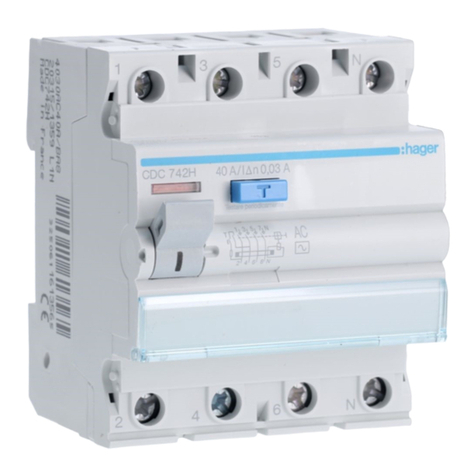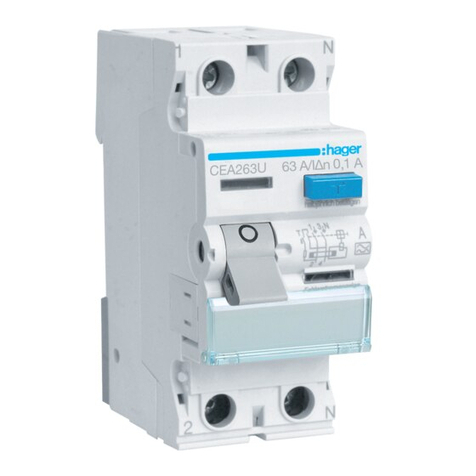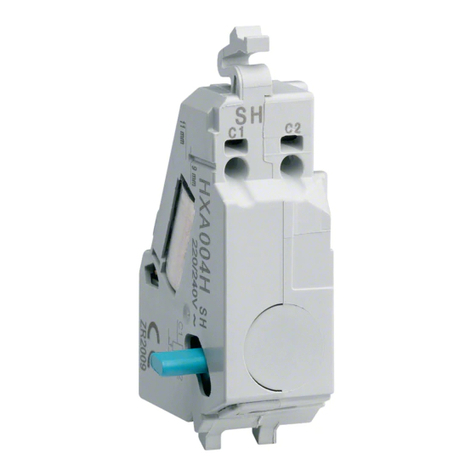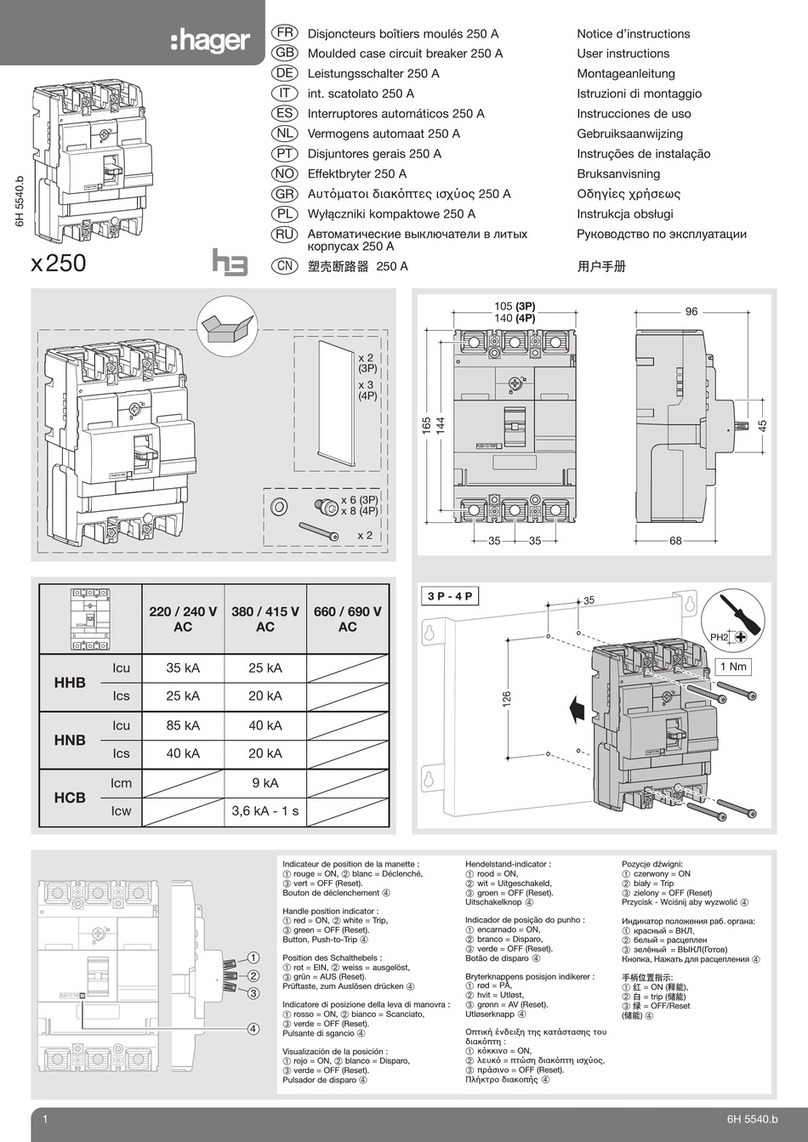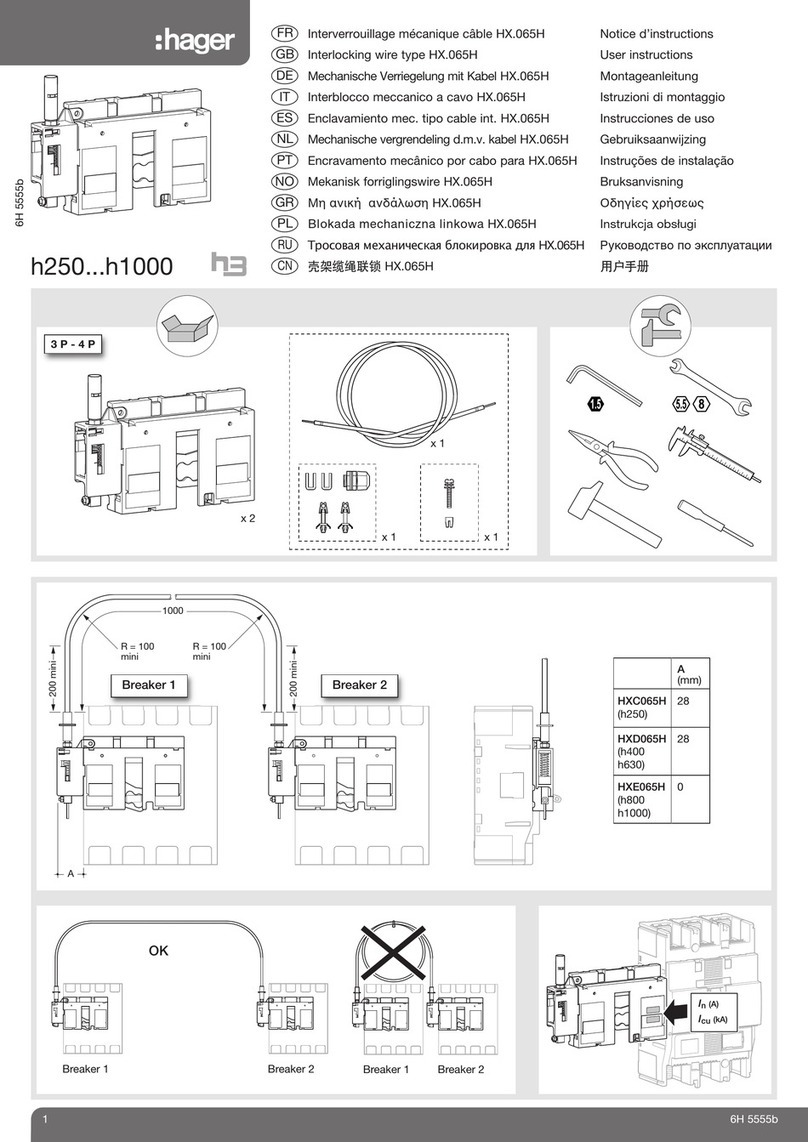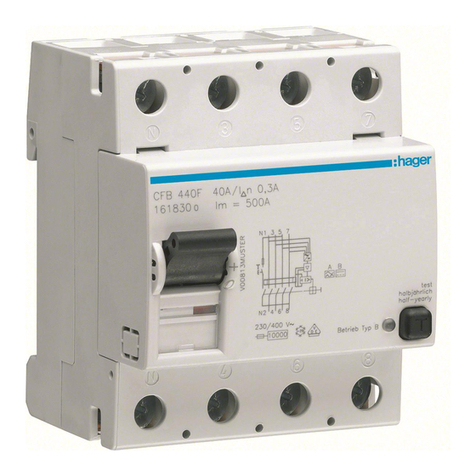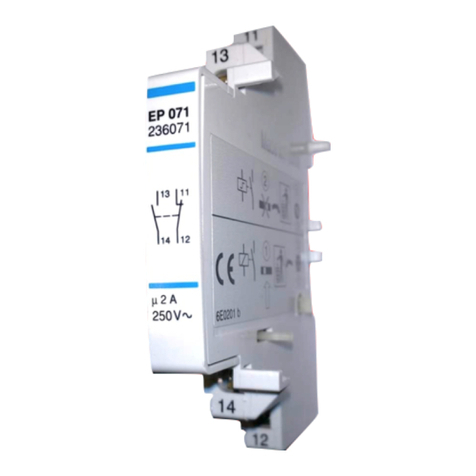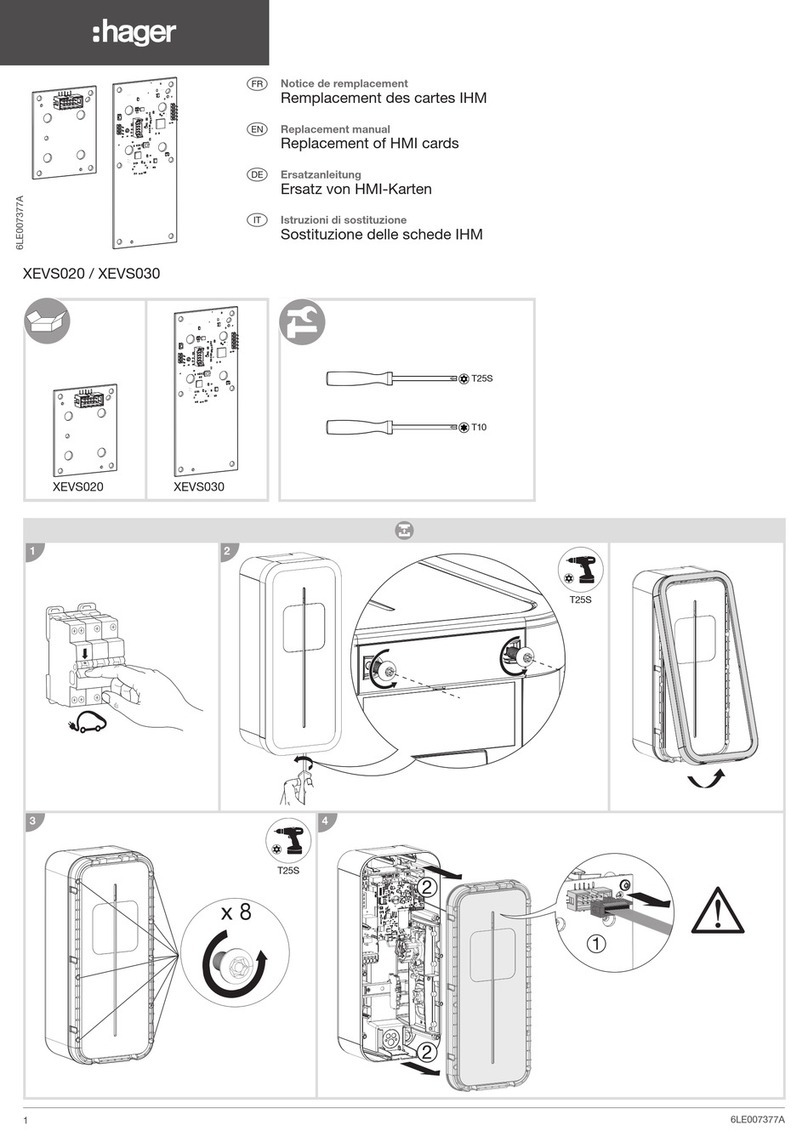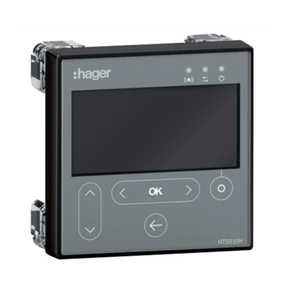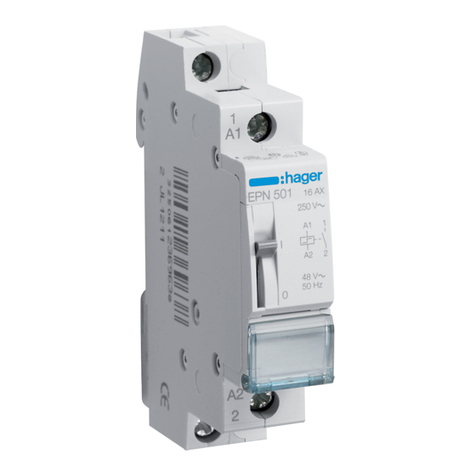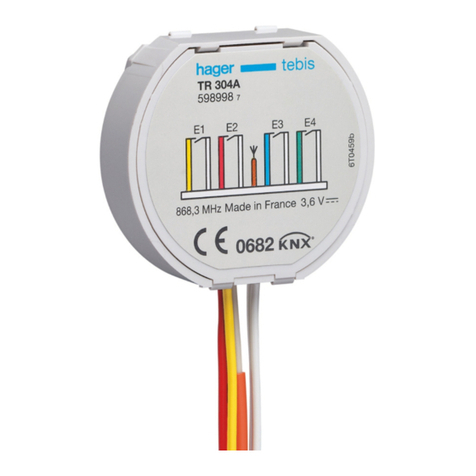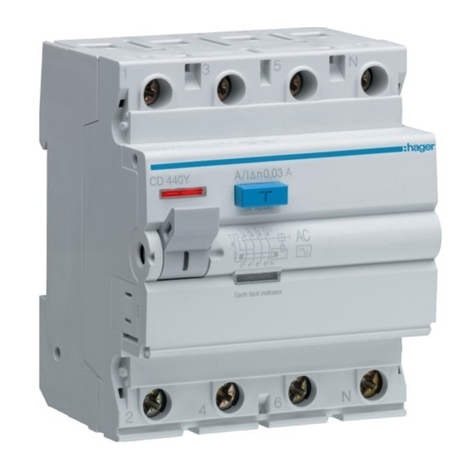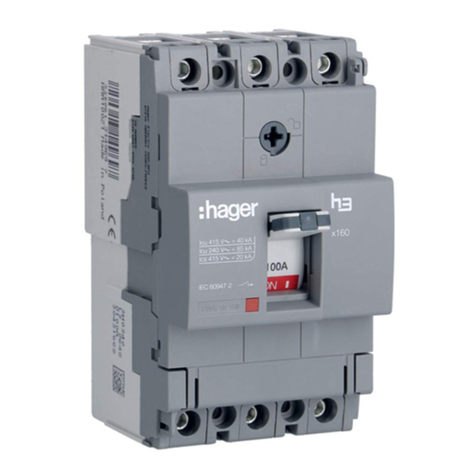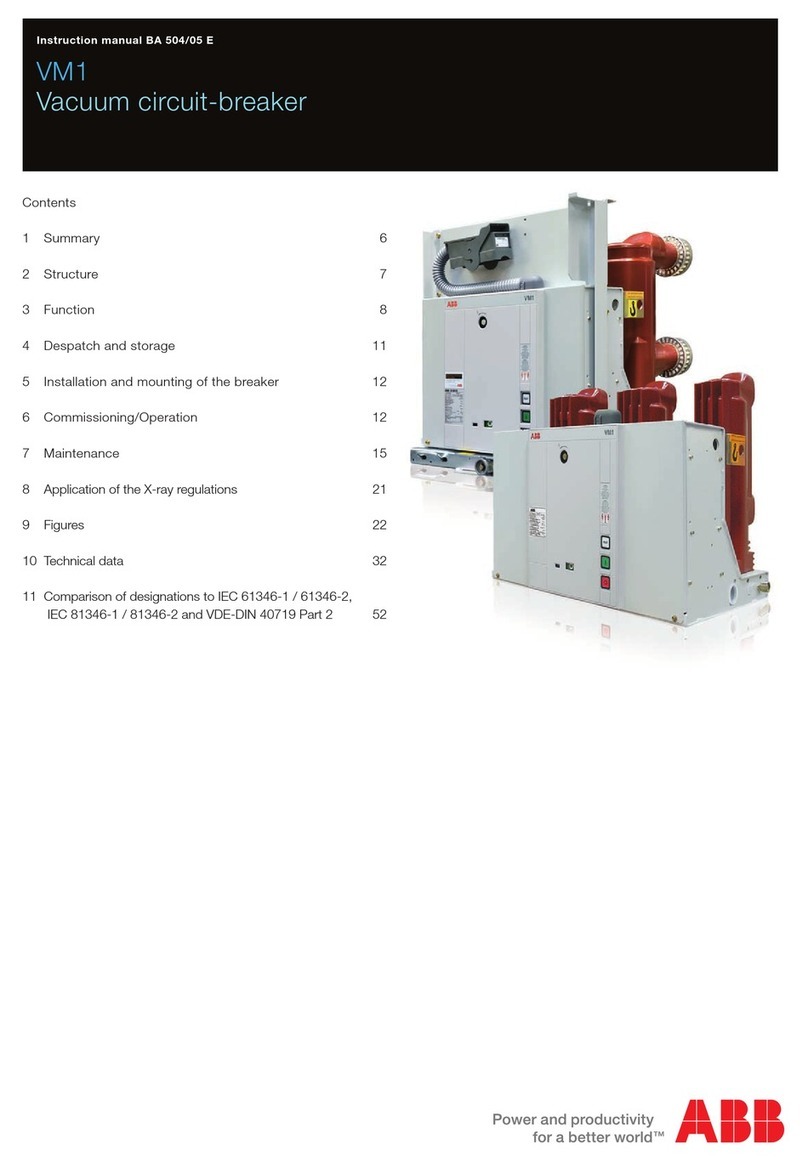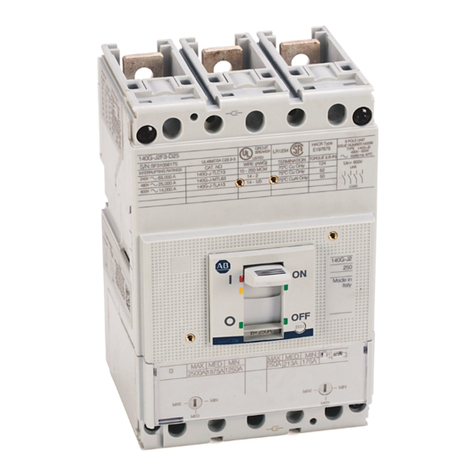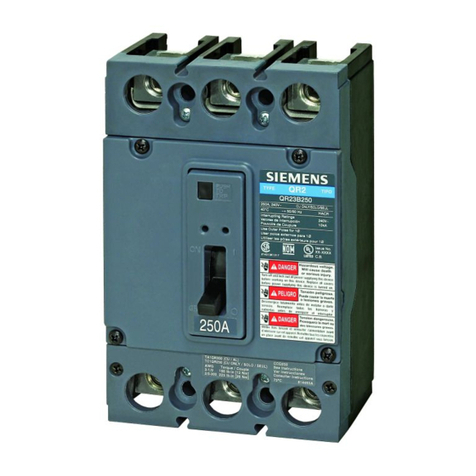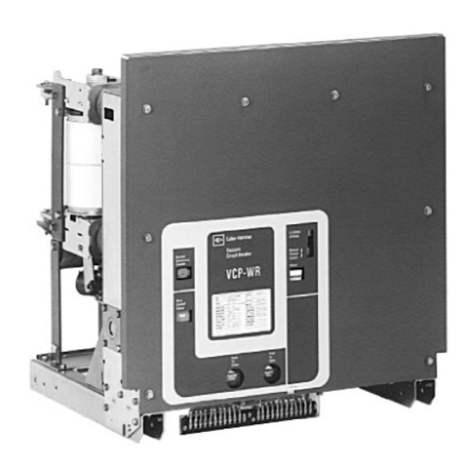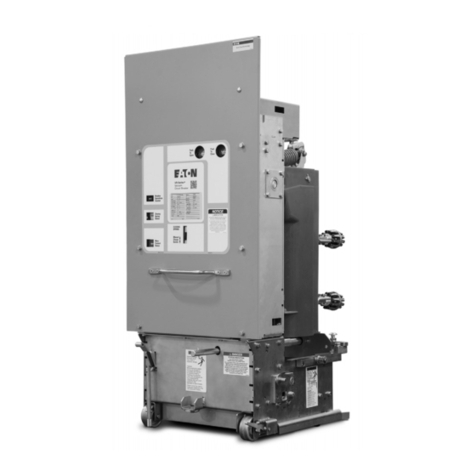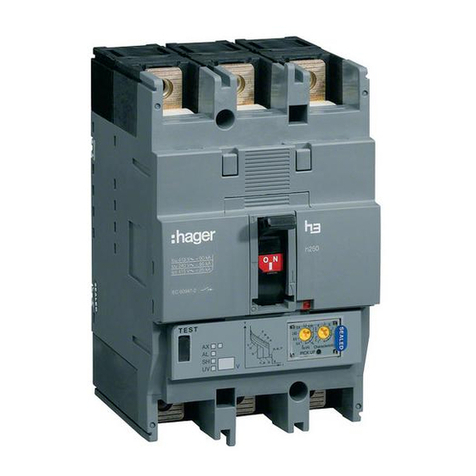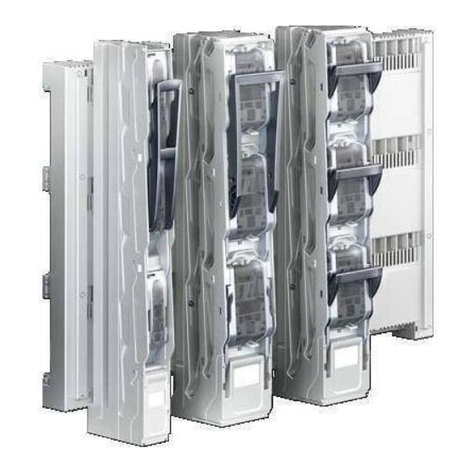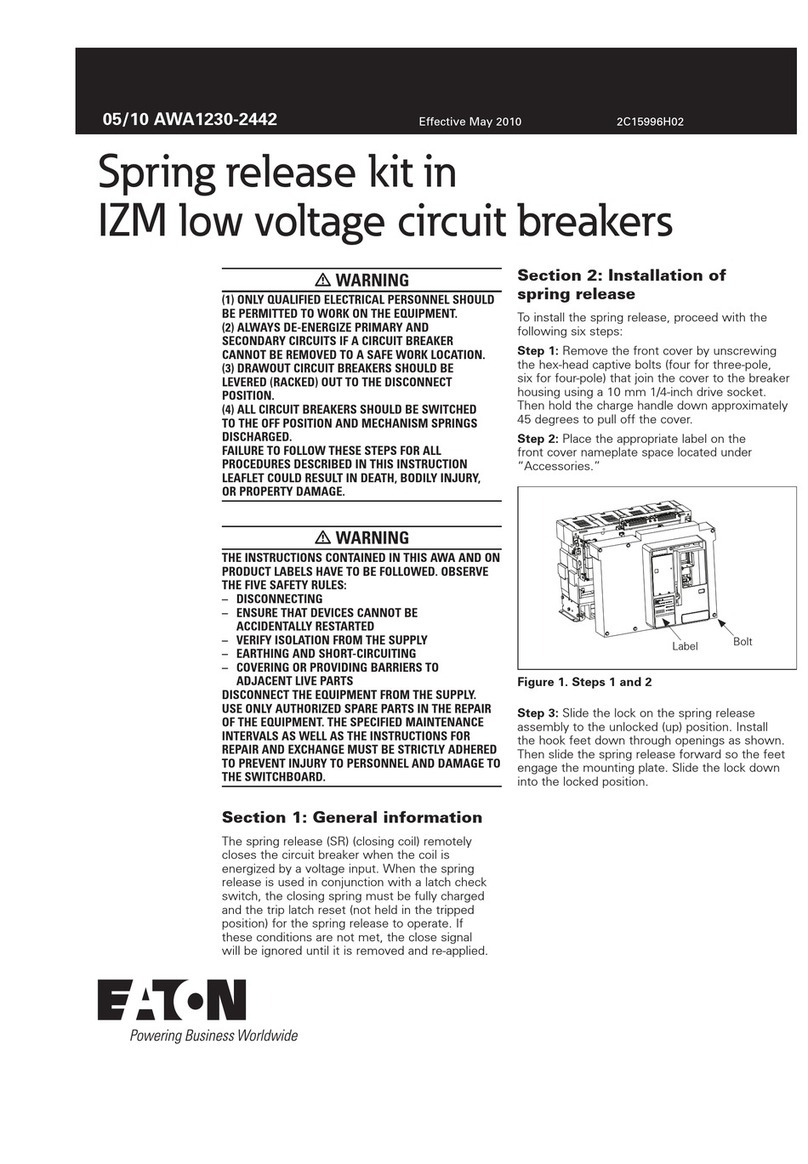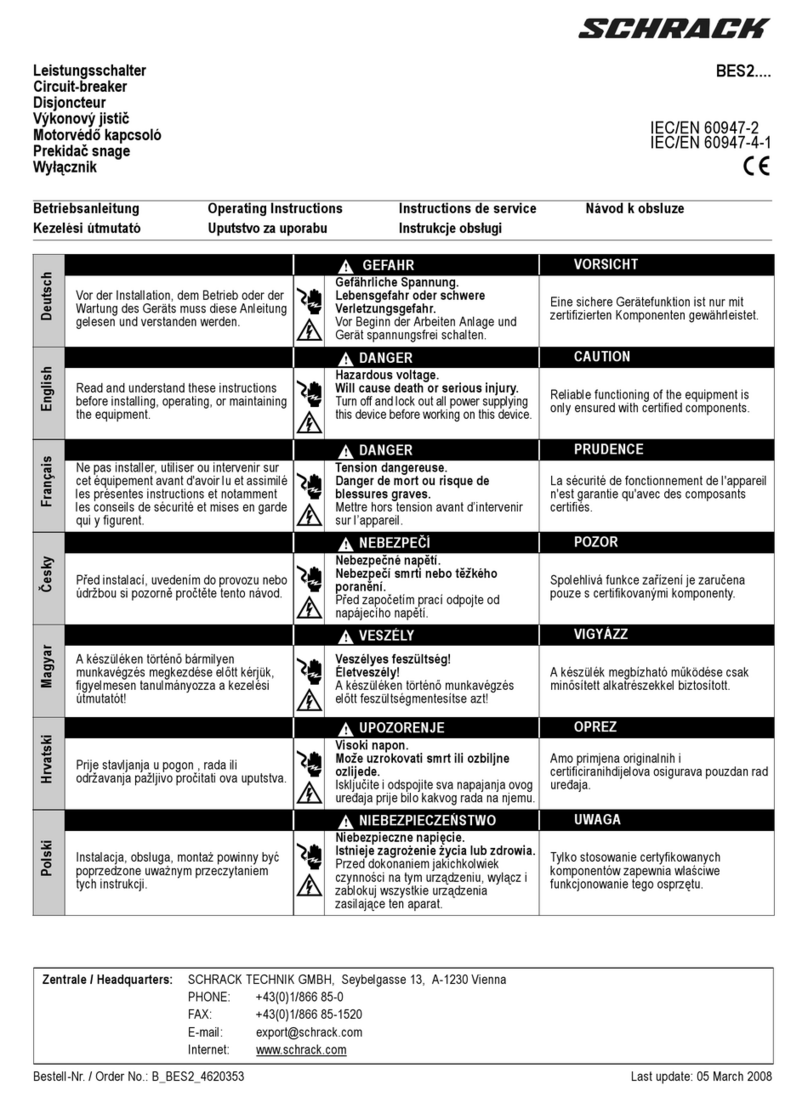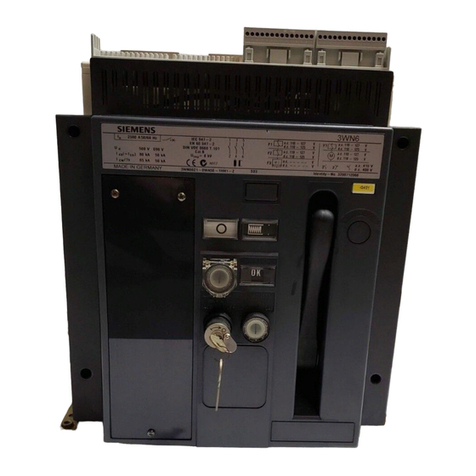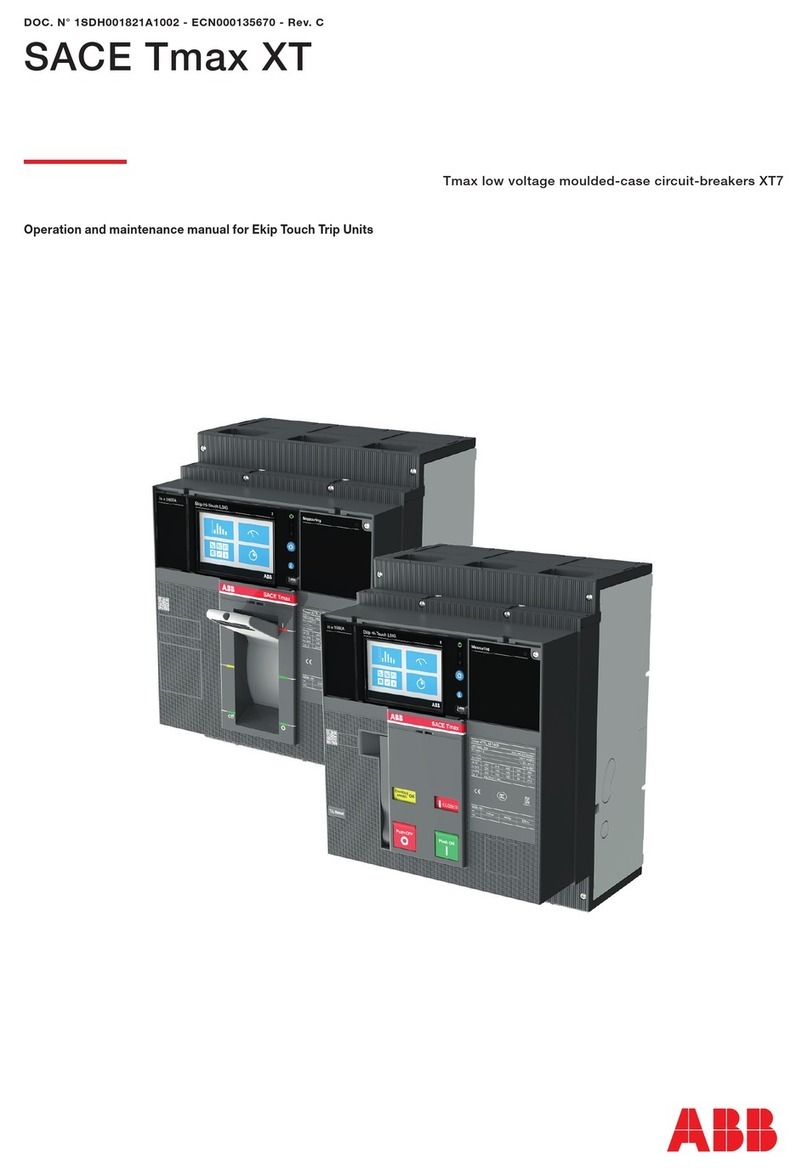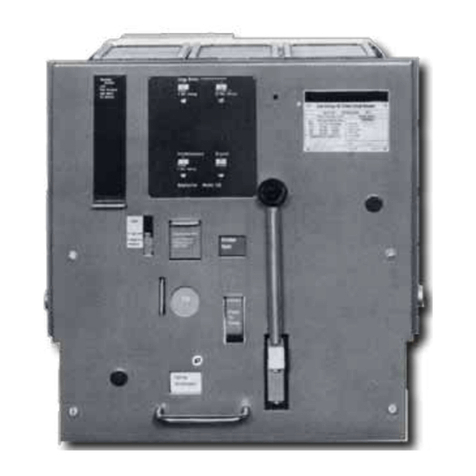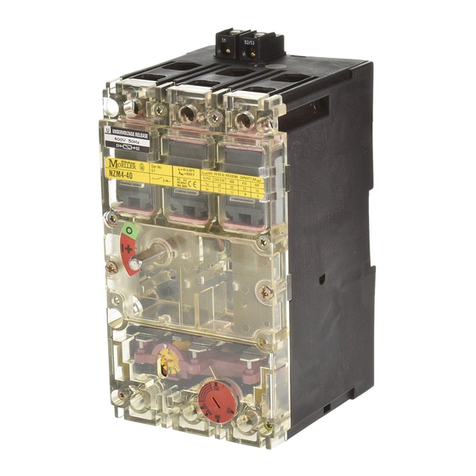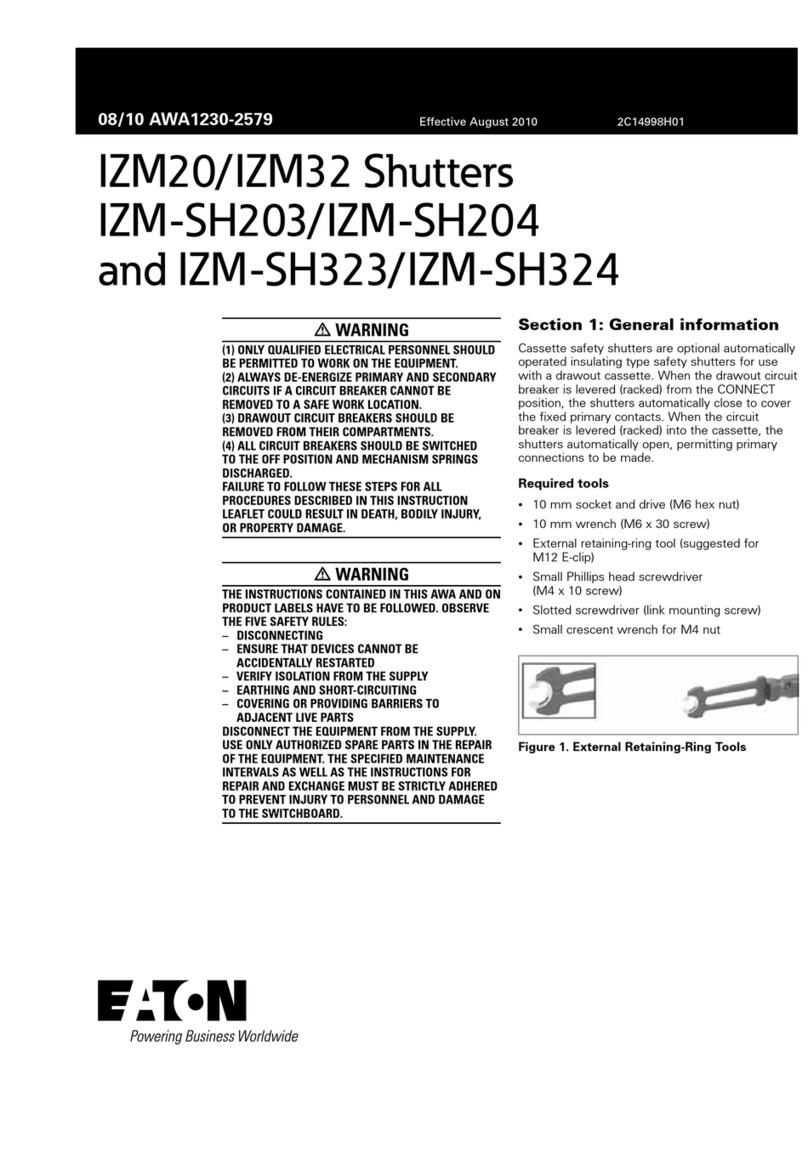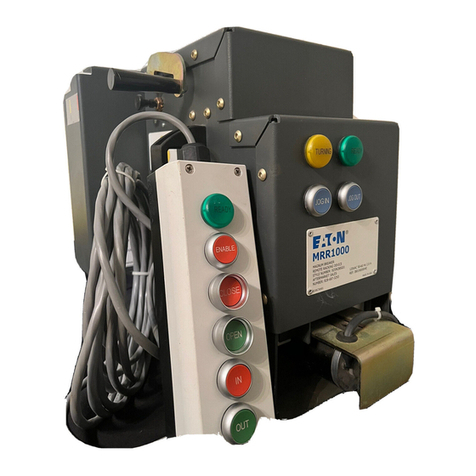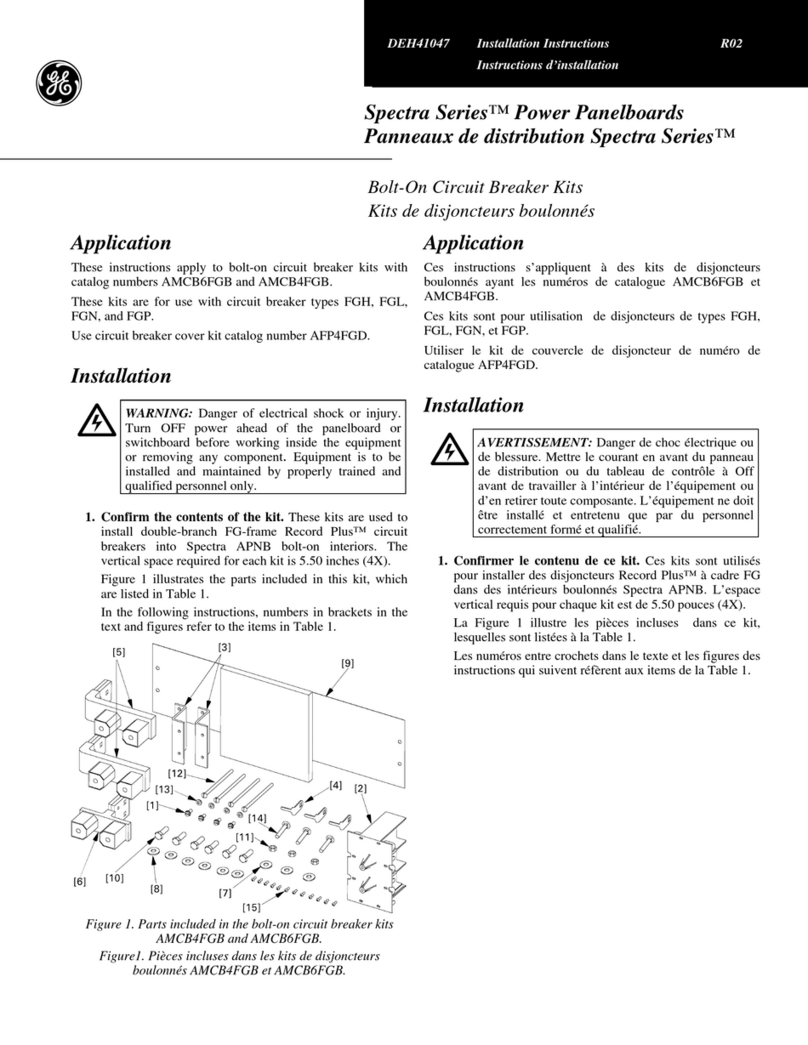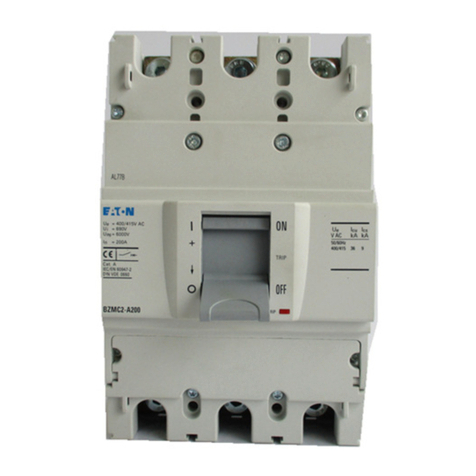
1 Hager Controls S.A.S., 33 rue Saint-Nicolas, B.P. 10140, 67703 SAVERNE CEDEX, France - www.hager.com
6LE000492A
WUT10N
KNX Tastsensor-Modul 1fach/
2 Tasten mit integr. Busankoppler
KNX push-button module
1gang/2 buttons with integr. bus
application unit
Module du bouton poussoir 2
touches avec coupleur de bus
intégré
WUT20N
KNX Tastsensor-Modul 2fach/
4 Tasten mit integr. Busankoppler
KNX push-button module
2gang/4 buttons with integr. bus
application unit
Module du bouton poussoir 4
touches avec coupleur de bus
intégré
e
z
a
06/2015 - 6LE000492A
Sicherheitshinweise e
Einbau und Montage elektrischer Geräte dürfen
nur durch eine Elektrofachkraft erfolgen. Dabei
sind die geltenden Unfallverhütungsvorschriften
des Landes zu beachten.
Bei Nichtbeachten der Installationshinweise kön-
nen Schäden am Gerät, Brand oder andere Ge-
fahren entstehen.
Bei Installation und Leitungsverlegung die für
SELV-Stromkreise geltenden Vorschriften und
Normen einhalten.
Bei Renovierungsarbeiten das Gerät gegen Ver-
schmutzung durch Farbe, Tapetenkleister, Staub
etc. schützen. Gerät kann beschädigt werden.
Diese Anleitung ist Bestandteil des Produktes
und muss beim Endkunden verbleiben.
Geräteaufbau
Bild 1: Geräteaufbau
(1) Tast-Abdeckung mit Linse (nicht im Lieferumfang)
(2) Tastsensor-Modul
(3) Befestigungsklammern
(4) Rahmen (nicht im Lieferumfang)
(5) Tragring mit Krallenbefestigung
(6) Schraube für Demontageschutz
(7) Status-LEDs
Funktion
Systeminformationen
Dieses Gerät ist ein Produkt des KNX-Systems und
entspricht den KNX-Richtlinien. Detaillierte Fach-
kenntnisse durch KNX-Schulungen werden zum
Verständnis vorausgesetzt. Planung, Installation und
Inbetriebnahme erfolgen mit Hilfe einer KNX-zertifi -
zierten Software.
system link Inbetriebnahme
Die Funktion des Gerätes ist softwareabhängig. Die
Software ist der Produktdatenbank zu entnehmen.
Produktdatenbank, technische Beschreibungen sowie
Konvertierungs- und weitere Hilfsprogramme fi nden
Sie stets aktuell auf unserer Internet-Seite.
easy link Inbetriebnahme
Die Funktion des Gerätes ist konfi gurationsabhängig.
Die Konfi guration kann auch mit Hilfe von speziell für
die einfache Einstellung und Inbetriebnahme entwi-
ckelter Geräte erfolgen.
Diese Art der Konfi guration ist nur mit Geräten des
easy link Systems möglich. easy link steht für eine
einfache, visuell unterstützte Inbetriebnahme. Hierbei
werden vorkonfi gurierte Standard-Funktionen mit
Hilfe eines Service-Moduls den Ein-/Ausgängen
zugeordnet.
Bestimmungsgemäßer Gebrauch
- Bedienen von Verbrauchern, z. B. Licht EIN/AUS,
Dimmen, Jalousie AUF/AB, Speichern und Aufru-
fen von Lichtszenen etc.
- Montage in Gerätedose nach DIN 49073
Produkteigenschaften
- Inbetriebnahme und Programmierung in S-Mode
und E-Mode
- Tastsensor-Funktionen: Schalten/Dimmen, Jalou-
siesteuerung, Wertgeber, Szenenaufruf, Vorgabe
der Heizungsbetriebsart, Zwangssteuerung, Stu-
fenschalter und Vergleicher-Funktion
- Eine Status-LED je Wippe
- Status-LEDs für das Gerät in Funktion und Farbe
parametrierbar
- Integrierter Busankoppler
Bedienung
Das Auslösen von Funktionen und Steuern von elek-
trischen Verbrauchern erfolgt über die Tastbereiche
(Bild 2, gestrichelt) und ist für jedes Gerät individuell
konfi gurierbar.
Zwei Bedienarten sind zu unterscheiden:
- Einfl ächenbedienung:
Das Ein-/Ausschalten oder heller/dunkler Dimmen,
z. B. einer Beleuchtung, erfolgt abwechselnd durch
wiederholtes Betätigen eines Tastbereiches.
- Zweifl ächenbedienung:
Zwei übereinander liegende Tastbereiche bilden
ein Funktionspaar. Betätigen oben z. B. schaltet/
dimmt eine Beleuchtung ein/heller, Betätigen unten
schaltet/dimmt eine Beleuchtung aus/dunkler.
Funktion oder Verbraucher bedienen
Die Bedienung von Verbrauchern, wie Beleuchtung,
Jalousie etc., erfolgt über die Tastfl ächen und hängt
von der Konfi guration des Gerätes ab.
Einen Tastbereich betätigen.
Die hinterlegte Funktion wird ausgeführt.
Der Betätigungsimpuls liegt für die Dauer der
Betätigung an. Funktionsabhängig können kurze
und lange Betätigungen unterschiedliche Aktionen
auslösen, z. B. Schalten/Dimmen.
P
(1)
(2) (3)
(4)
(5)
(6)
(7)
1
2
Safety instructions z
Electrical equipment may only be installed and
assembled by a qualifi ed electrician. Always fol-
low the relevant accident prevention regulations
of the country.
Failure to comply with these installation instruc-
tions may result in damage to the device, fi re or
other hazards.
When installing and laying cables, always comply
with the applicable regulations and standards for
SELV electrical circuits.
During renovation work, protect the device from
pollution by paint, wallpaper paste, dust etc. The
device can be damaged.
These instructions are an integral component of
the product and must be retained by the end us-
er.
Design and layout of the device
Figure 1: Design and layout of the device
(1) Touch cover (not within scope of delivery)
(2) Push-button module
(3) Fastening clamps
(4) Frame (not within scope of delivery)
(5) Supporting ring with prong connection
(6) Screw for dismantling protection
(7) Status LEDs
Function
System information
This device is a product of KNX system and corre-
sponds to the KNX guidelines. Detailed specialised
knowledge obtained from KNX training courses
is required for comprehension. The planning, installa-
tion and commissioning are carried out with the help
of KNX-certifi ed software.
system link start-up
The function of the device is software-dependent. The
software is to be taken from the product database. You
can fi nd the latest version of the product database,
technical descriptions as well as conversion and addi-
tional support programmes on our website.
easy link start-up
The function of the device is confi guration-dependent.
The confi guration can also be done using devices devel-
oped specially for simple setting and start-up.
This type of confi guration is only possible with devic-
es of the easy link system. easy link stands for easy,
visually supported start-up. Preconfi gured standard
functions are assigned to the in/outputs by means of
a service module.
Correct use
- Operation of consumers, e.g. light on/off, dim-
ming, blind up/down, saving and opening light
scenes, etc.
- Installation into wall box according to DIN 49073
Product characteristics
- Start-up and programming in S-mode and E-mode
- Push-button functions: switching/dimming, blind
control, value transmitter, scene call-up, specifi ca-
tion of the heating operating mode, forced control,
stepping switch and comparator function
- One status LED per rocker
- Function and colour of the status LEDs confi gur-
able for the device
- Integrated bus coupling unit
Operation
Triggering of functions and operation of electrical
loads takes place via touch surfaces (fi gure 2,
dashed) and can be set individually for each device.
There are two operating modes:
- Single-surface operation:
Switching lighting on/off and dimming brighter/
darker is carried out alternately by repeated
touching of a touch surface.
- Two-surface operation:
Two superimposed touch surfaces form a function
pair. For example, touching the top surface switch-
es/dims lighting on/makes it brighter, touching the
bottom surface switches it off/makes it darker.
Operating a function or load
Consumers, such as lighting, blinds, etc., are operat-
ed using the touch surfaces, which are dependent on
the device confi guration.
Touch a touch surface.
The stored function is executed.
The actuation pulse lasts for the duration of the
actuation. Depending on the function, short and
long touches can trigger different actions, e.g.
switching/dimming.
P
Consignes de sécurité a
L‘installation et le montage d‘appareils élec-
triques doivent être effectués uniquement par un
électricien qualifi é. Les prescriptions de préven-
tion des accidents en vigueur dans votre pays
doivent être respectées.
Le non-respect des consignes d‘installation peut
entraîner des dommages sur l‘appareil, un incen-
die ou présenter d‘autres dangers.
Veuillez observer les prescriptions et les normes
en vigueur pour les circuits électriques TBTS lors
de l‘installation et de la pose des câbles.
En cas de travaux de rénovation, veuillez proté-
ger l‘appareil contre la peinture, les colles de pa-
pier peint, la poussière etc.. L’appareil risque
d’être endommagé.
Ce mode d‘emploi fait partie intégrante du pro-
duit et doit être conservé par l‘utilisateur fi nal.
Composition de l’appareil
Image 1: Description de l‘appareil
(1) Enjoliveur avec voyant (non fourni)
(2) Mécanisme du bouton poussoir
(3) Clips de fi xation
(4) Plaque décorative (non fourni)
(5) Support avec fi xation à griffes
(6) Vis antivol
(7) LED d‘état
Fonction
Informations système
Cet appareil est un produit du système KNX et est
conforme au standard KNX. Des connaissances spé-
cialisées détaillées dispensées par le biais de forma-
tions KNX sont nécessaires pour la compréhension du
système. La programmation, l‘installation et la mise en
service s‘effectuent à l‘aide d‘un logiciel certifi é KNX.
Mise en service system link
Les fonctions précises de ces produits dépendent
de la confi guration et du paramétrage. Le logiciel
d‘application est disponible dans la base de données
produits. La base de données produit, les descrip-
tions techniques, les programmes de conversion
ainsi que d‘autres logiciels d‘assistance à jour sont
disponibles sur notre site Internet.
Mise en service easy link
Les fonctions précises de ces produits dépendent de la
confi guration et du paramétrage. La confi guration peut
être réalisée par un outil de confi guration dédié qui per-
met un paramétrage et une mise en œuvre simplifi és.
Cette méthode de confi guration ne peut être utilisée
qu‘avec des produits compatibles easy link. La méthode
de confi guration easy link permet, au travers d‘une inter-
face graphique, une mise en œuvre simplifi ée. Ainsi, des
fonctions de bases pré-confi gurées sont affectées aux
entrées et aux sorties via l‘outil de confi guration.
Cas d‘usage typique
- Exemples d’application ; MARCHE/ARRÊT de la
lumière, variation, OUVERTURE/FERMETURE
des stores, sauvegarde et appel des scénarios
d‘éclairage etc.
- Montage dans une boîte d‘encastrement confor-
mement à DIN 49073
Caractéristiques du produit
- Mise en service et programmation en system link
et easy link
- Fonctions du bloc boutons poussoirs: commutation/
variation, commande des stores, transmetteur de
valeur, appel de scènes, détermination du mode de
fonctionnement du chauffage, commande forcée,
commutateur à plots et fonction comparateur
- Une LED d‘état par touche
- LED d‘état pour l‘appareil, fonctions et couleurs
paramétrables
- Coupleur de bus intégré
Fonctionnement
L’émission des fonctions et la commande des
charges électriques se font via les boutons poussoirs
(image 2, en pointillés) et il est possible de les confi -
gurer individuellement pour chaque appareil.
Il faut faire la différence entre les deux types de
commande:
- Commande mono bouton:
L‘activation / la désactivation de l‘éclairage ou la
variation (plus clair/plus foncé) par ex. s‘effec-
tue(nt) par alternance en appuyant successive-
ment sur un bouton poussoir.
- Commande avec 2 boutons:
Deux boutons poussoirs (un supérieur et un infé-
rieur) forment une paire fonctionnelle. Appuyer sur
la partie supérieure pour allumer/régler un éclairage
plus clair; appuyer sur la partie inférieure pour
éteindre/régler un éclairage plus sombre.
Utilisation de la fonction ou de la charge
L‘utilisation de charges telles que l‘éclairage, les
stores, etc. s‘effectue grâce aux boutons poussoirs et
dépend de la programmation de l‘appareil.
Appuyer sur un bouton poussoir.
La fonction mémorisée est exécutée.
L‘impulsion activant la fonction ne dure que le temps
de l’appuis sur le bouton. Selon les fonctions, un
appui court ou prolongé peut provoquer des actions
différentes, comme par ex. commuter/varier la lumi-
nosité.
P


